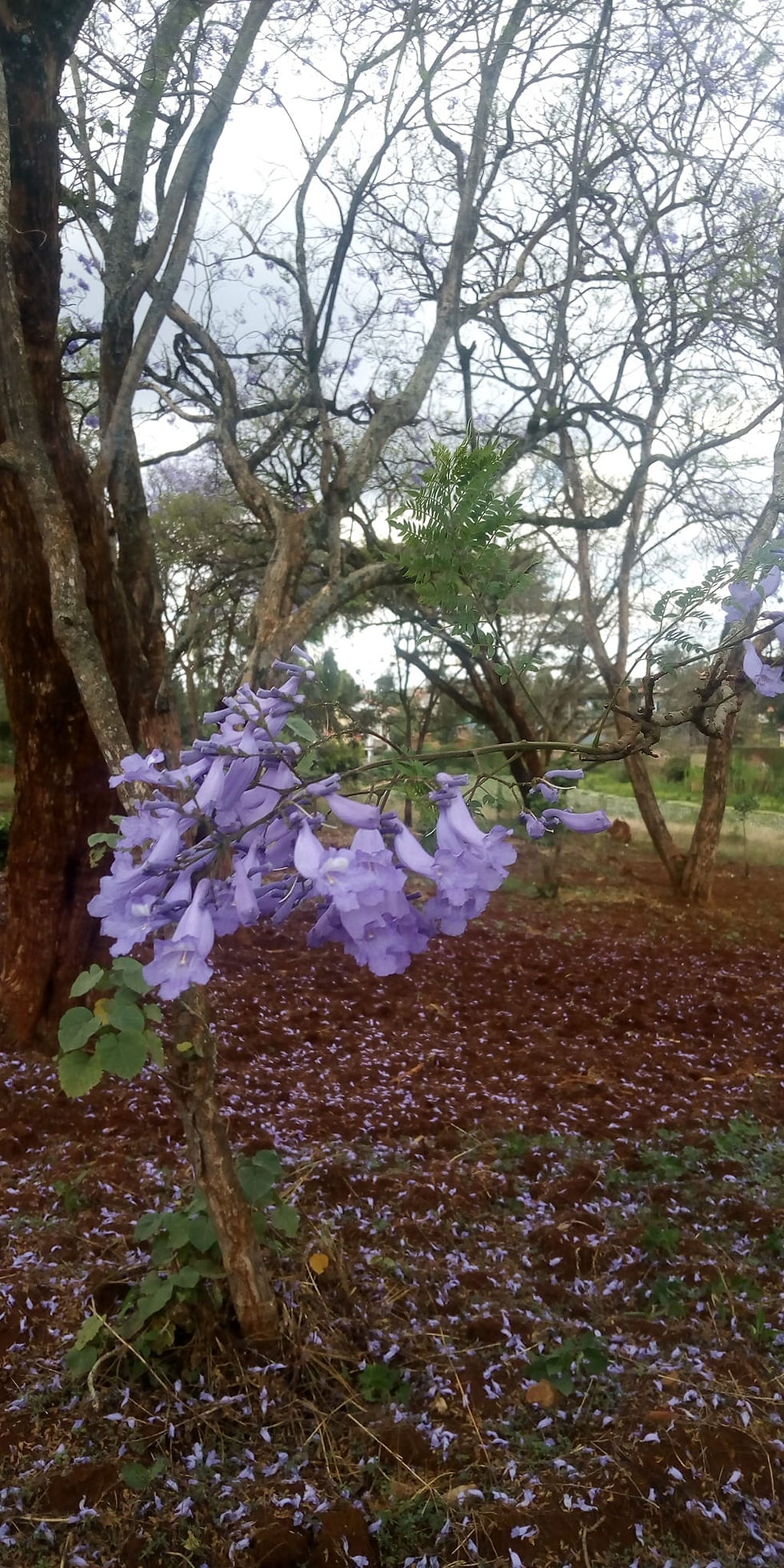Blue Jacaranda Seedlings for Sale – Fast-growing & Vibrant Blooms!
- BeyondForest

- Oct 11, 2024
- 6 min read
Updated: Sep 18

1.)Blue Jacaranda Leaves
3.)Blue Jacaranda Flowers
6.)Uses of Jacaranda Tree
7.)Tourism and Recreation around the Blue jacaranda
8.)Environmental benefits of the Blue jacaranda
9.)Disadvantages of the blue jacaranda

Image of Jacaranda mimosifolia on the road
The blue jacaranda, scientifically known as Jacaranda mimosifolia, is a striking tree species renowned for its vibrant purple-blue flowers. Native to the tropical and subtropical regions of South America, particularly in Brazil, it has gained popularity worldwide for its ornamental beauty and versatility.

Image of Jacaranda Fruit shells
The tree’s unique aesthetic appeal and ecological benefits make it a significant addition to urban and rural landscapes alike. This essay delves into the botanical characteristics, ecological roles, and the substantial economic importance of the blue jacaranda.

Image of a Jacaranda mimosifolia in marurui estate
The blue jacaranda is a medium-sized tree, typically reaching heights of 10 to 15 meters (33 to 49 feet) with a similar spread. Its broad, rounded canopy provides ample shade, making it suitable for parks and streetscapes.

Image of well layered Jacaranda mimosifolia tree
The tree has finely divided, fern-like leaves that are a vibrant green. Each leaf can be up to 30 cm long, consisting of numerous small leaflets arranged in pairs. This feathery foliage adds to the tree’s aesthetic appeal.
The trees in CBD, Aga Khan walk, and along Langata Road were planted by the disgraced Town Clerk Gakuo in 2007-2008.
Blue Jacaranda Leaves
The Blue Jacaranda (Jacaranda mimosifolia) has distinctive leaves that are as beautiful and unique as its flowers. The leaves are bipinnate, meaning they are divided into smaller leaflets that are further subdivided into even smaller leaflets.

Image of Blue jacaranda seedlings
A single leaf can grow between 30 and 50 cm (12–20 inches) in length. Each compound leaf is made up of numerous tiny leaflets, which are usually 1–2 cm (0.4–0.8 inches) long. The leaves are typically a vibrant light green to medium green. During the dry season, Jacaranda trees may shed their leaves partially or entirely, depending on the climate.
Jacaranda Wood is used for poles, carvings and bee forage.

Image of Blue jacaranda seedlings on recycled containers
Jacaranda Common Names
Jacaranda is referred to as Mucakaranda Tree in Kikuyu Language and Umosaria in Kisii language
Jacaranda flowers are tubular and bell-shaped, typically around 2.5–5 cm (1–2 inches) long.

Image of flowers of the blue jacaranda
One of the most distinguishing features of the jacaranda is its stunning flowers. The trumpet-shaped blooms appear in clusters and can range from lavender to deep purple. They typically bloom in late spring to early summer, creating a spectacular floral display that attracts various pollinators, including bees and butterflies.
Jacaranda seeds are small, flat, and have a papery wing around the seed body, aiding in wind dispersal. The seeds are encased in a woody, flat, round pod that splits open when mature, revealing numerous flat, winged seeds. These seeds are lightweight and designed to be dispersed by wind, allowing the tree to propagate naturally.

Blue jacaranda Tree fruits
The jacaranda produces elongated, woody pods that contain several flat, winged seeds. These pods can be up to 5 cm long and typically mature in the fall, dispersing seeds that can lead to natural regeneration.
Jacaranda grows in most soils except waterlogged areas while Flowering occurs around October/November.

Image of a Blue jacaranda Tree fruit
Do jacaranda trees grow in Kenya?
Yes, Jacaranda trees grow in Kenya and are quite popular in various regions due to their beauty and adaptability. These trees thrive in Kenya’s warm, tropical, and subtropical climates, making them a common sight in cities, towns, and rural areas. acaranda trees are often planted along roads, parks, and residential areas in cities like Nairobi, Mombasa, and Kisumu

Image of Blue jacaranda seedlings
Can you grow jacaranda from seed
Yes, you can grow a Jacaranda tree from seed! It is one of the most common methods of propagation for this stunning tree .Locate a mature Jacaranda tree and look for its seed pods. These are round, woody, and flat, measuring about 5–7 cm in diameter. Harvest the pods once they turn brown and start to crack open naturally. Allow the pods to dry fully if they are not already split, then open them to extract the flat, winged seeds.

Image of Blue jacaranda seeds
Jacaranda (Jacaranda mimosifolia) trees with their lavender-blue flowers, that are trumpet shaped and lightly fragrant, make this tree a memorable attraction during this time of the year!
How long do jacaranda seeds take to germinate
Jacaranda seeds typically take 2 to 4 weeks to germinate under optimal conditions, though it can sometimes take longer depending on the environment and the quality of the seeds. Ensuring proper preparation and creating a conducive environment can help improve germination rates and shorten the time required.

Image of Blue jacaranda tree seeds on the ground
How much are jacaranda tree seedlings in Kenya?
Based on general trends, the price for Jacaranda seedlings in Kenya typically ranges from Ksh 50 to Ksh 200 per seedling, depending on the size, age, and location of the nursery.
What is the lifespan of a jacaranda tree?
The lifespan of a Jacaranda tree (Jacaranda mimosifolia) is typically around 50 to 75 years under favorable conditions, but some trees can live beyond 100 years with proper care and an ideal environment
Benefits of Jacaranda Tree
Ornamental Value
The vibrant purple-blue flowers create a breathtaking display, making the Jacaranda tree a popular choice for landscaping in parks, streets, and gardens. Its feathery leaves add an elegant, tropical touch even when the tree is not in bloom. During the flowering season, the tree transforms urban spaces into picturesque landscapes.
Environmental Benefits
Jacaranda trees absorb carbon dioxide and release oxygen thus improving air quality.
The tree's wide canopy provides ample shade, making it ideal for areas with intense sunlight, such as parks, schools, and public spaces.
Its root system helps prevent soil erosion, especially in sloping areas.
The tree provides a habitat for birds, insects, and small animals, enhancing local ecosystems.
Economic Benefits
While not as commercially significant as hardwoods, the timber of jacaranda is valued for its fine grain and workability. It is lightweight and resistant to warping, making it suitable for various applications, including furniture, cabinetry, and musical instruments.

Image of Blue jacaranda tree trunk
Cities and towns with Jacaranda-lined streets often attract visitors during the blooming season, boosting local tourism.

Image of Jacaranda Tree trunk in Marurui dam
Medicinal Uses
Traditional medicine practices use parts of the Jacaranda tree for various treatments Leaves and bark extracts are used to treat skin conditions like wounds, ulcers, and rashes.Decoctions made from the leaves are sometimes used to manage fever.

Image of jacaranda tree at nairobi CBD
Tourism and Recreation around the Blue Jacaranda
The breathtaking blooms of jacaranda trees during flowering season draw tourists, generating revenue for local economies. Cities known for their jacaranda-lined streets often promote these attractions through festivals and events.

Image view of Kunming street lined with blooming purple jacaranda trees by China Xinhua News on X
Carbon Sequestration
As a tree species, jacarandas contribute to carbon sequestration, helping to mitigate climate change impacts. This can enhance sustainability efforts and may qualify for carbon credits under various environmental programs.
Soil Erosion Control
The tree's root system helps stabilize soil, reducing erosion in vulnerable areas, particularly in urban settings.

Image of a Blue jacaranda tree flower
Invasive Potential
In some regions, jacaranda has become invasive, outcompeting native species and disrupting local ecosystems. Careful management and monitoring are essential to mitigate this risk.
The tree requires regular maintenance, including pruning and care to prevent pests and diseases. This can involve costs for local governments and homeowners.
Pest and Disease Susceptibility
Jacarandas can be susceptible to various pests, such as scale insects and aphids, as well as diseases like root rot. Integrated pest management strategies are necessary to ensure tree health.
Water Requirements
Although relatively drought-tolerant, prolonged dry conditions can affect flowering and overall health. In arid regions, supplemental irrigation may be necessary.




Comments